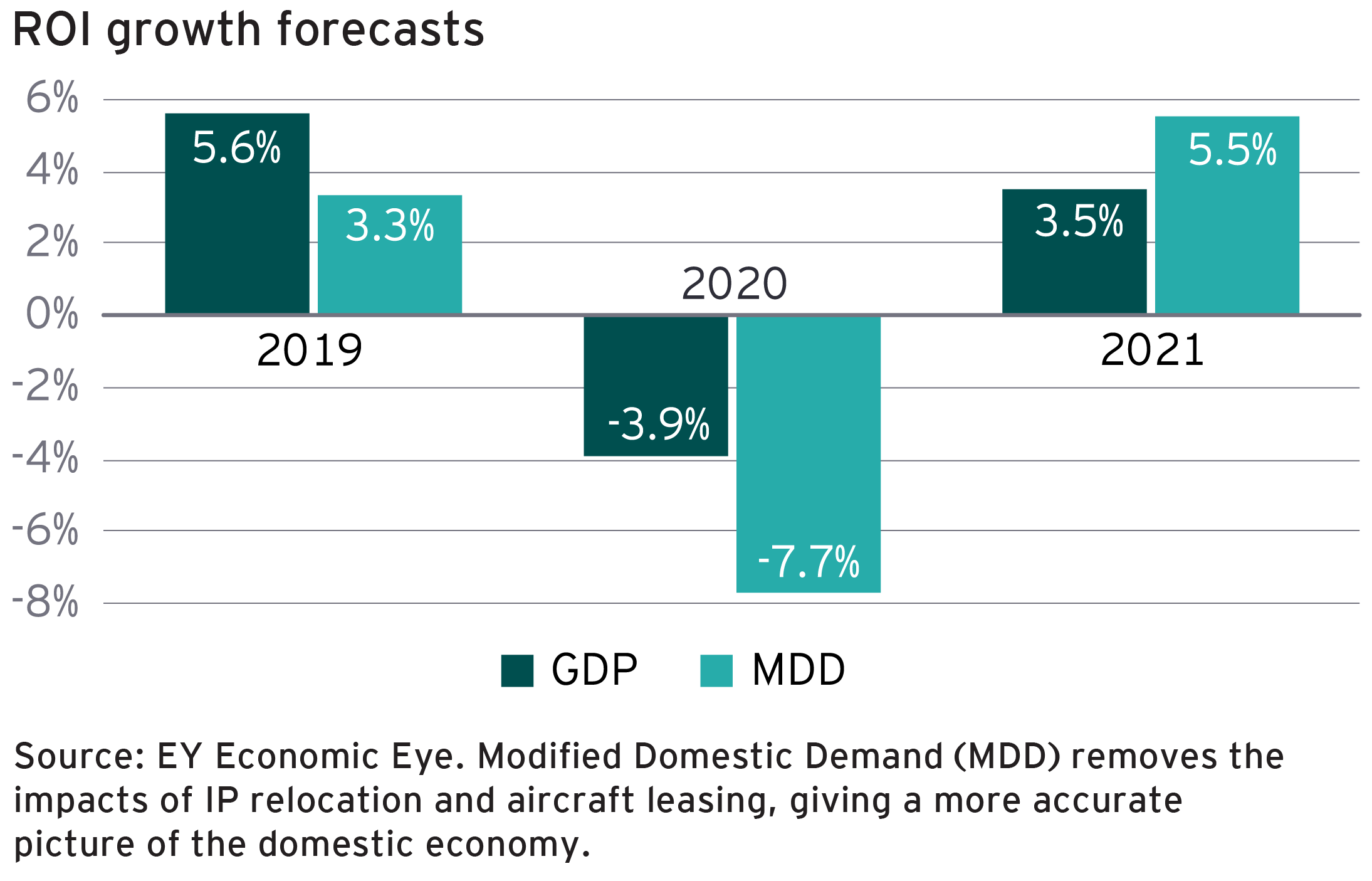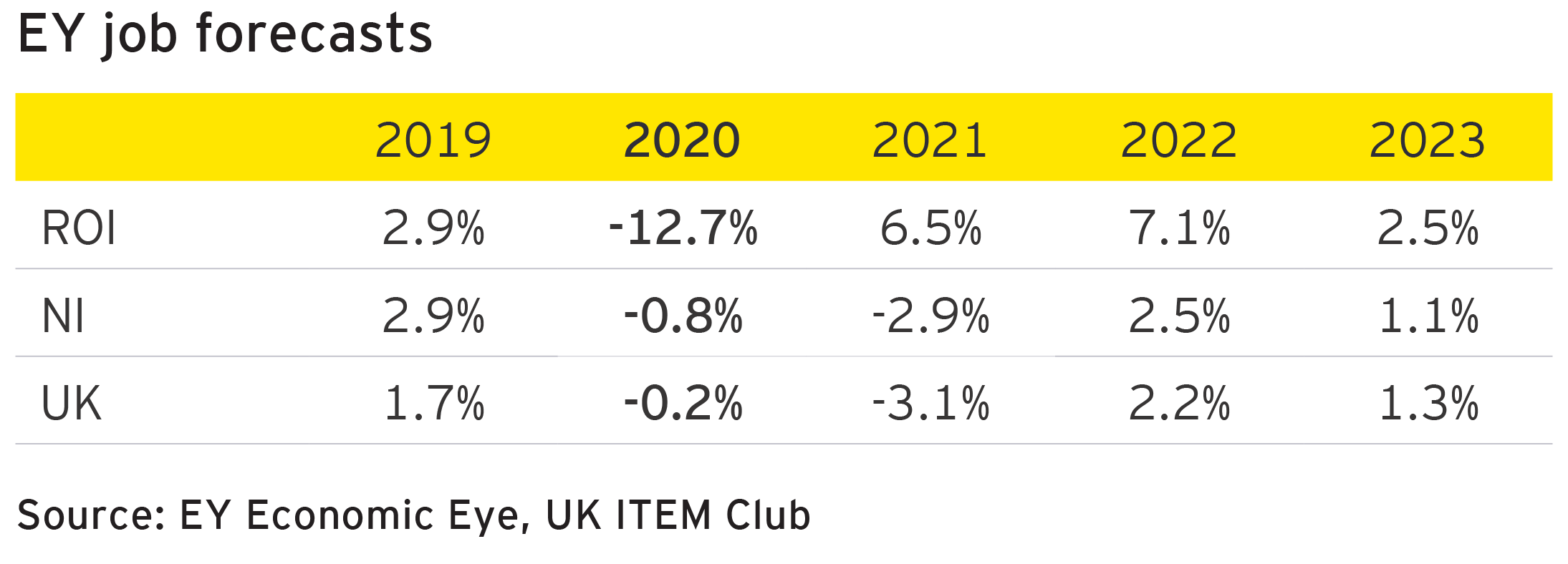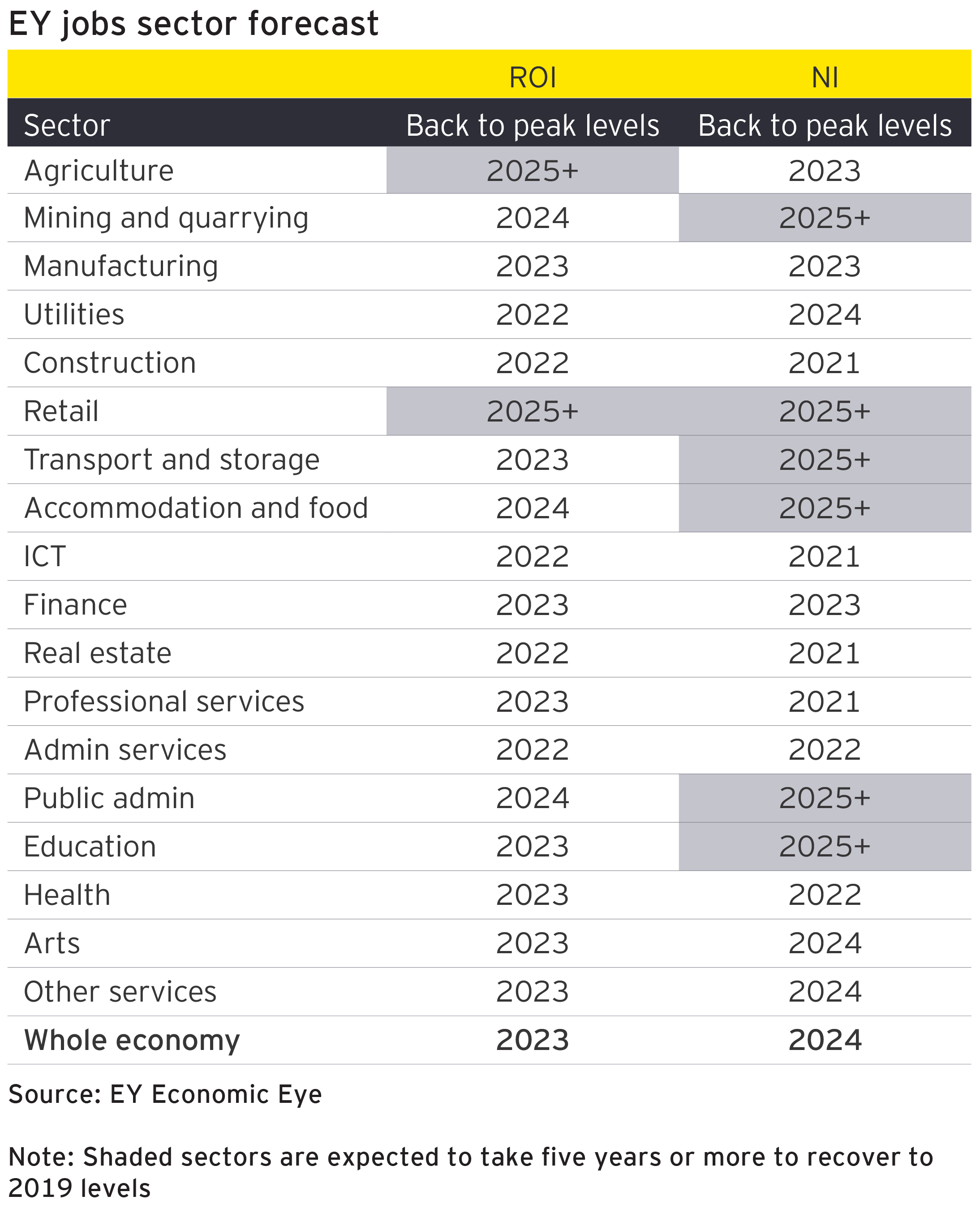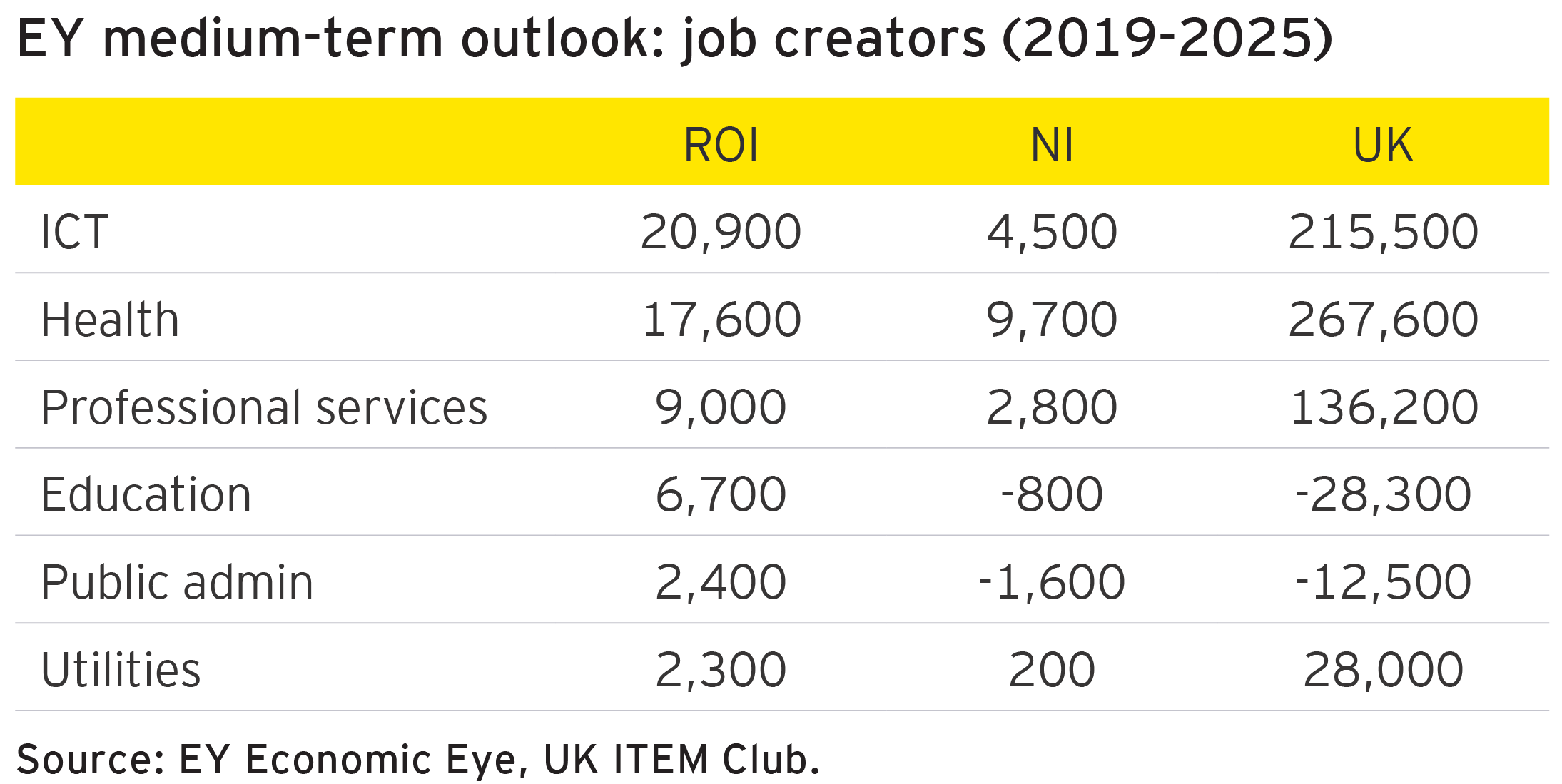EY refers to the global organization, and may refer to one or more, of the member firms of Ernst & Young Global Limited, each of which is a separate legal entity. Ernst & Young Global Limited, a UK company limited by guarantee, does not provide services to clients.

It is certain that 2020 will be remembered as a year of profound disruption and change, one in which our way of living and working has totally transformed. Hopefully, it will also be remembered as a time when we recognised our own fragilities and those of our planet, as well as the need for a proactive and dynamic government to help us through challenging times.
Read the online version of the Economic Eye Report, or download the full PDF version below.
Chapter 1: Executive Summary
Chapter 2: Global outlook
Chapter 3: Republic of Ireland
Chapter 4: Headline growth forecasts
Chapter 5: UK macroeconomic drivers
Chapter 6: Labour market
Chapter 7: Brexit
Chapter 8: What lies beyond

Chapter 1
Executive Summary
How to measure the impact and form a view of the future?
Uncertain trends in health policy and a complex political environment across the globe have made this the most challenging all-island Economic Eye forecast to produce. The data which forms the building blocks of all economic models is incredibly complex to decipher at present and differences in measurement and policy frameworks make it almost impossible to compare the two economies. Through the lens of GDP, ROI appears to have fared much better than NI.
Pandemic resurgence halting the recovery
Towards the end of the summer, monthly GDP forecast models for the two economies were edging upwards, particularly in ROI as Q2 data was factored in. The resurgence of COVID-19 cases and the return of restrictions have sadly moved the forecasts into reverse. ROI is predicted to contract by 3.9% in 2020 and NI by 10.9% before modest recoveries of 3.5% and 5.5% in 2021.
Changed forever?
Long-term forecasting typically relies on historical data to help determine the trends and relationships that underpin our economy. The acceleration of digital, the move to online shopping, more time at home, or away from the office and a realignment of what truly matters to citizens may completely change the direction of many sectors across the economy.


Chapter 2
Global outlook
Forecasts improving, but second wave may impact
Global forecasts have endured a roller-coaster ride during 2020. Initial projections of the impact of COVID-19 were relatively modest until the true scale of the pandemic and the ensuing necessary policy interventions became clear. Outlooks were subsequently revised down during the darkest months of the first wave in late spring and early summer. However, as restrictions began to lift, the resurgence in spending levels and confidence led to a return to the ‘V’ shaped narrative and expectations that the bounce back would be swifter than originally expected.


Chapter 3
Republic of Ireland
Headline growth forecasts
ROI is projected to suffer its largest year-on-year contraction in GDP since 2009, before bouncing back modestly in 2021 and accelerating thereafter.

Consumers down 10.7%
Consumer spending is projected to contract by 10.7% in 2020, reflecting periods of restrictions during the year and the increased level of caution due to fears of job losses and future income falls.
However, savings deposits have risen sharply and retail sales data in late summer reflect a willingness to bounce back amongst consumers
Investment down 35.9%, excluding intangibles down 16.8%
With most building sites closed, a quarterly fall of 28.4% was recorded in Q2. With the housing market proving more robust than many forecasters expected and no requirement for sites to close in the latest restrictions, the bounce back has been relatively strong. A strong pipeline of government investment spending should provide an offsetting boost, helping investment to a strong forecast of 8.2% in 2021 after a contraction of 35.9% in 2020
Government up 13%
Government spending is expected to contribute positively to Irish GDP in 2020 as increasing health spending and other COVID-19-related spending flows into the economy. In the UK, real GDP in the government sector is measured differently and is linked to activity levels rather than wages paid. As such, it fell sharply in Q2 2020. Despite similar increases in nominal spending figures, the government sector is expected to increase by 13.0% in ROI but fall by 8.2% in the UK due entirely to the difference in measurement approach.
Trade, exports up 1.4%
Overall exports are expected to increase in 2020 by 1.4%. ROI remains one of the most popular relocation destinations for producers moving out of the UK. Exports are expected to remain an important driver of growth with 5.8% projected in 2021, despite possible disruption to trade with Britain, one of ROI’s biggest markets.
Trade, imports down 10.3%
The strength of exports in 2020 prevents import levels from falling in line with the contraction in consumer spending. It is possible that Brexit will force import substitution, particularly in food, if a deal is not secured by 1 January 2021.

Chapter 4
Northern Ireland and the UK
Headline growth forecasts
NI GDP is projected to fall by 10.9% in 2020 before recovering by 5.5% in 2021, compared to a fall of 10.1% and a rebound of 6.0% in 2021 in the UK.

Encouragement in the data
The labour market has shown remarkable resilience leading up to and throughout the pandemic. Unemployment spiked sharply at the beginning of the pandemic, but stabilised very quickly, remaining at a lower level than projected. This partly reflects the effectiveness of the furlough scheme, which has now been extended, but is also an endorsement of the flexibility and adaptability of NI businesses and workers, a commonly cited positive amongst investors to NI.
Will NI productivity be digitally enhanced?
Digital technology is unlocking considerable productivity gains across a wide range of firms, but there is a concern that in a region heavily dominated by very small firms, there may be a lack of resources to make this investment.
Long-term strength may lie in broader measures of success
One of the most encouraging aspects of the longer-term outlook is NI’s strong performance on many quality of life or wellbeing metrics. These are increasingly being considered as a more effective way to measure true economic and social progress and the region is actively embracing them as their framework for the future.

Chapter 5
Northern Ireland and the UK
UK macroeconomic drivers
Consumers down 12.8%
UK consumer spending is projected to contract by 12.8% in 2020, a comparable level to ROI, reflecting the broadly similar behavioural impacts of COVID-19. In NI, an early move to enhanced restrictions on 16 October is likely to have curtailed the strong bounce in consumer spending that was underway. However, there are some areas of growth amidst the disruption. Jobs are being created for delivery drivers and in the digital sector, as firms pivot to new operating models
Government down 8.2%
At a UK level, the government sector is projected to fall by 8.2% in real terms in 2020, despite a strong rise in nominal spending levels. and the equivalent NI figure would be similar.
Investment down 17.2%
Investment levels have long been weak in the UK and despite a commitment to increased government investment, the forecasts for investment growth remains modest, with a contraction of 17.2% forecast in 2020 followed by growth of 3.4% in 2021
Trade exports down 11.5.%
The contraction of 11.5% is only partially offset in 2021 with growth of 10.6% projected.
Trade imports down 18.1%
Imports have contracted in the UK, as expected, along with exports and consumer spending which fell sharply. The pickup projected in consumer spending should drive import levels back up in 2021 with growth of 16.3% forecast, though Brexit could disrupt this and drive increased levels of domestic demand, as local suppliers substitute for imports.

Chapter 6
Labour market
The pandemic has brought disruption to even this most consistent of data sources.
In ROI, the PUP scheme which initially offered a relatively high level of weekly income for those made redundant, was taken up by 600,000 people at its peak, over 25% of the workforce. No such scheme existed in the UK, where its furlough scheme (paying 80% of wages for people unable to work) was the main intervention.
The schemes have evolved in both economies, and continue to do so in response to the changing conditions and policy direction.
Employment in ROI is forecast to contract by 12.7%, with NI falling by a much more modest 0.8%. This apparent divergence is due to the absence of an adjusted employment figure for NI. The recovery is stronger in ROI, but in both economies, the labour market is not forecast to regain its 2019 peak until 2023. Unemployment is expected to climb to 16.1% in ROI for 2020 on an annual average basis. In NI the LFS unemployment rate is expected to average under 5% for the calendar year, though it was projected to be over 7% by years end.

In ROI, 25.7% of the workforce was employed in retail, accommodation, arts and other services at the end of 2019, the sectors at the front line of the COVID-19 disruption. In NI, the figure is broadly similar at 26.9% (26.6% in the UK). This is a stark reminder of the importance that these jobs play in the labour market and therefore, societal and community damage that could be caused.

There is broad consensus across forecasters that ICT and professional services are likely to be major job creators in the UK and ROI, and to a lesser degree, a similar view exists over health.


Chapter 7
Brexit
Businesses must step forward into growth because stepping back, or standing still, simply is not an option.
At EY, we are currently using the framework of “Now, Next & Beyond” to help our clients think about managing change and uncertainty. There are three issues to consider moving beyond Now, into Next and Beyond.
Optimise
- Safeguarding trade flows and how the business operates, by examining what is working in the supply chain and identifying areas for improvement. This could be identifying areas for improvement, such as the location of material suppliers
- Taking advantage of alternatives to reducing or eliminating tariffs (depending on location)
- Putting support processes on a permanent footing (e.g. IT and staffing) by streamlining processes and making changes to IT systems which provide the maximum efficiency benefits
Build resilience
COVID-19 and Brexit planning teams should be brought together, so the business is looked at holistically or thematically rather than being based on individual issues. As you move to Beyond, how does the business become more resilient? This resilience is across the organisation, including balance sheet, IT, people, supply chain/operations and stakeholder management.
Manage uncertainty
The world continues on an unceasing arc of complexity and unpredictability. With an unprecedented level of technological development, and a more interconnected world than ever, the complexity of the current landscape is continually increasing. How is your business configured to identify, respond and react to these factors? After COVID-19, Brexit, political turmoil and civil unrest, what’s next and what does it mean for your business?

Chapter 8
What lies beyond
Business leaders across the island of Ireland, and indeed all over the world, are turning their attention to the shape of post-pandemic.
The “back to normal” fallacy
Without an effective deployed vaccine or better treatments, we will have to live with cycles of resurgence and potential mutation that could last for many more months, if not years.
Continual economic shockwaves
The economic effects of the pandemic vary greatly by industry with retail, travel, hospitality and leisure industries amongst the hardest hit. Government supports are buffering the economic shock, but business leaders are wondering how long can the supports be sustained?
Mass-market digitisation
The lockdowns and social distancing measures have accelerated digital business. These trends were already happening but the overnight shift to digital by the traditionally slow adopter consumer segments has seen a landslide to digital customer interaction and cashless transactions. There has been a surge in uptake by digital first timers and an extension of digital service consumption to a wide array of emerging new services such as medical consultations, fitness training and education.
From quick-fix tech to sustainable solutions
Overall business leaders are relieved at how quickly their organisations have been able to sustain business working from home (WFH). In most cases, their technology was imperfect for a long-term switch and had been designed for partial WFH policies. Investments have been ramped up to implement enduring and secure WFH infrastructure, usually with video and collaboration software.
The people and culture conundrum
Business leaders are universally concerned about the impact of WFH on their employees. The potential effects of isolation and the wider COVID-19 human impacts on wellbeing and mental health are top of mind. Measures to survey and check in on staff have been widely implemented.
Hybrid models for collaboration, innovation and esprit de corps
Leading organisations have been learning from “born on the web” companies who use collaboration technologies to facilitate ideation and design thinking sessions. However, even the most advanced are missing the opportunities to bring people together physically at times.
The future is agile
In a world where physical and virtual meetings are small and short, leaders are looking at ways to divide up the work into more manageable chunks. They see the future as lots of smaller interdependent things being progressed in shorter “sprints” which will require management to learn new ways of co-ordination.
Business and societal convergence
Many business leaders are stepping up to see how they can give something back to limit the wider downside and help emerge well. Community has become more important to employees as they reconnect locally and there is a greater awareness of the environmental consequences of a commuter-based model. There is a recognition that the burden of restarting the economy cannot rest entirely with government. Businesses can invest in creating jobs, apprenticeships, reskilling and education to the benefit of society as a whole. Big business has a role to play in helping small and medium businesses.
Summary
COVID-19 and Brexit are the twin challenges that dominate an assessment of the island economy in late 2020, but the outlook is about more than these two unpredictable forces. Beneath the headlines are pockets of remarkable transformation, ingenuity and prosperity. Firms across the island are not looking to simply bounce back to where they were, they are striving to step forward into a reshaped world full of opportunity.
This article is also co-authored by Katherine Doyle, Economist EY Ireland and Brian Cronin, Economist EY Ireland.




